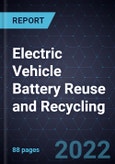Government Regulations and Environmental Concerns Prompt Market Participants to Establish Circular Economy
Environmental concerns resulting from the increasingly apparent climate change effects drive the worldwide adoption of sustainable transportation. With governments phasing out vehicles that run on fossil fuels through stringent emissions regulations, people are purchasing electric vehicles (EVs) in significant numbers. The global EV market recorded over 75.6% revenue growth in 2021, increasing battery demand.
However, when they reach the end of their life as EV batteries, they still have 60% to 70% of their capacity. This opens up opportunities to repurpose batteries in second-life applications and recycle them to extract valuable elements such as cobalt and nickel, leading to the growing EV battery reuse and recycling market.
Although the current market trend indicates a preference for recycling in the short term (two to three years), rising technological sophistication, proven business models, and clear regulations will increase second-life applications in the long term.
In this report, the analyst analyzes the following market aspects:
- Regulatory framework by region, including global, Europe, China, and Japan
- Value chain, business models, and prominent participants
- Top automotive EV OEMs’ plans and alliances on battery reuse and recycling
- Major battery recycling companies by region (the Americas, Europe, China, and Asia-Pacific)
- Strategic imperatives and growth opportunities
Table of Contents
Companies Mentioned (Partial List)
A selection of companies mentioned in this report includes, but is not limited to:
- Umicore
- 4R Energy
- Ningbo Brunp CATL New Energy
- Li-Cycle
- Redwood Materials
- American Manganese
- Primobius
- Retriev Technologies
- Ganfeng Lithium
- Lithion Recycling








